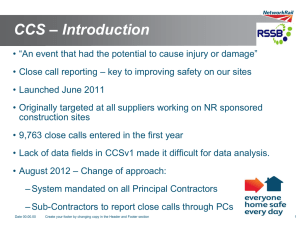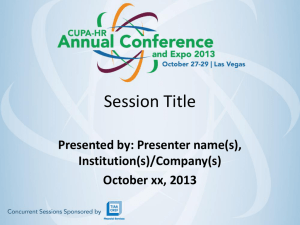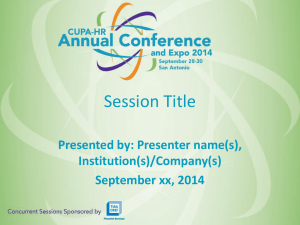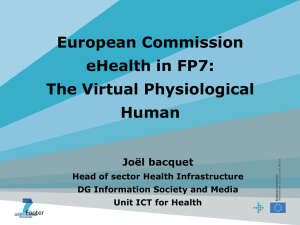Dementia Screening and Management
advertisement
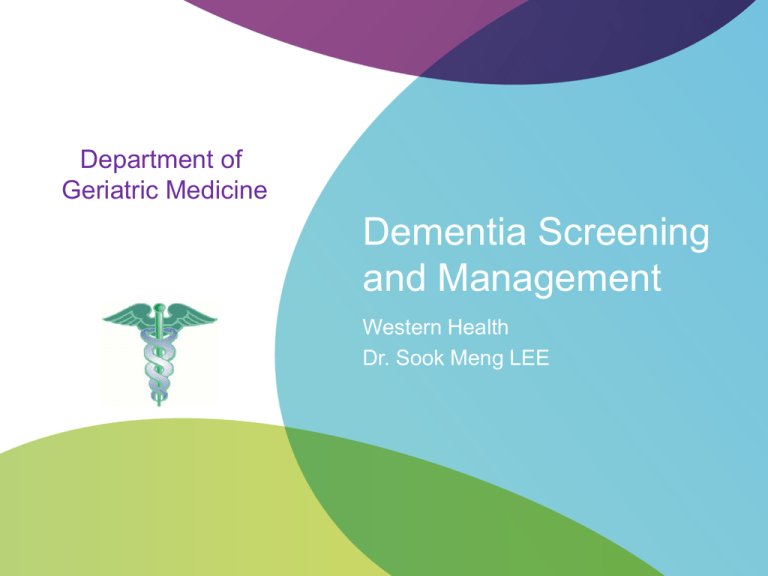
Department of Geriatric Medicine Dementia Screening and Management Western Health Dr. Sook Meng LEE Overview New terminology from DSM V What are some of the clues GPs might pick up? What are the reasons to seek early diagnosis? What screening tools to use? Evidence on treatments available and how to subscribe Who and how to refer to CDAMS and other services? Footer Text 2 Causes of cognitive decline Normal ageing Subjective Cognitive Impairment (SCI) Mild Cognitive Impairment (MCI) Dementia Delirium Depression Drugs anticholinergic, analgesics, antinauseants, antibiotics (cipro), CNS acting, cardiac, GI, psychotropics, steroids The 4 Ds Footer Text 3 New DSM V Terminology Neurocognitive disorder (NCD) vs Dementia Dementia typically refers to neurodegenerative disorders in the elderly DSM expands category to include disorders in younger people • eg. HIV, traumatic brain injury Can be single domain • eg. Amnestic • exception – Major NCD due to Alzheimer’s disease Footer Text 4 Criteria for Neurocognitive Disorders COGNITIVE disorders ACQUIRED and represent a DECLINE (ie not developmental) Presence of underlying brain pathology Footer Text 5 Major and Mild Neurocognitive Disorder Major Neurocognitive Disorder • • • • Significant cognitive decline Interferes with independence Not due to delirium Not due to other mental disorders Mild Neurocognitive Disorder • • • • Footer Text Moderate cognitive decline Does NOT interfere with independence Not due to delirium Not due to other mental disorders 6 Cognitive domains specified DSM-IV • Memory impairment • Aphasia • Apraxia • Agnosia • Executive dysfunction Footer Text DSM-V • Complex attention • Executive function • Learning & memory • Language • Perceptual-motor • Social Cognition 7 When diagnosing, it is just as important to eliminate non-NCD conditions to determine which disease(s) are present Amnestic syndromes – post-head injuries, psychogenic states, TLE Depression and Delirium • Complex relationship • Important – treatable Other, some possibly treatable/reversible/modifiable, causes of cognitive disorders including systemic, metabolic, endocrine, infective, nutritional, trauma, toxins (medications, alcohol), neurological (NPH, tumors) Footer Text 8 Clues Vague complaints Forgetting appointments, scripts Repetitive, word finding difficulties Irritable Recurrent attendance to ED Decline in previous well controlled illness Social withdrawal Holiday dramas FAMILY MEMBER and carer worried Footer Text 9 What are the common causes of NCD? Major types of NCDs Neurocognitive Disorder due to Alzheimer’s disease Vascular Neurocognitive Disorder Neurocognitive Disorder due to frontotemporal lobar degeneration Neurocognitive Disorder with Lewy Bodies Neurocognitive Disorder due to Parkinsons disease Traumatic brain injury Substance/medication-induced Prion disease (several others – up to 70 types) Footer Text 11 Alzheimer’s disease (1) Causes at least 50% of all neurocognitive disorders Characterised by insidious onset and slow steady progression Initially, new learning is affected (pervasive forgetfulness), later praxis, language and executive functions, loss of insight (anosognosia) “Probable” vs “Possible” Alzheimer’s disease Related to Evidence of AD gene (family history or formal gene testing) Footer Text 12 Alzheimer’s disease (2) Medial temporal lobe atrophy on MRI – highly predictive of AD PET scans – PiB PET, florbetapir amyloid PET NB variant Ads Specific medication available (cholinesterase inhibitors & memantine- not curative) Aβ plaques, neurofibrillary tangles, tau pathology Footer Text 13 Vascular neurocognitive disorder (1) NINDS-AIREN criteria • Temporal relationship/stepwise – but not always (infarcts may be silent) • Focal neurology • Neuroimaging evidence Clinical neurological signs ( motor, sensory, bulbar, gait, executive function, psychomotor slowing, apathy, urinary dysfunction, gait disorders) Memory deficits often milder than AD – due to retrieval difficulties rather than primary memory disorder, hence benefit from cues Footer Text 14 Vascular neurocognitive disorder (2) Slowed information processing, difficulty planning, organising, sequencing, set shifting Management includes optimisation of CVS risk factors inc antiplatelet Tx Depression, personality change, emotional lability Footer Text 15 Mixed pathologies Common – especially in the older patients Community study in those with clinical diagnosis of dementia • 50% mixed pathology – most common AD and VaD • AD + PDD, AD + DLB Brain Banks (Europe) • 53% mixed pathology • Brain pathology also found in those without clinical diagnosis during life (brain reserve theory) Footer Text 16 NCD with Lewy Body Disease (1) Common accounting 10-25% dementia Core symptoms • Insidious onset and progression of debilitating cognition over 1-4 years • Fluctuating cognition/attention/alertness • Visual hallucinations – well formed and detailed • Parkinsonism develops 12/12 AFTER cognitive impairment Suggestive features • Rapid eye movement (REM) sleep disorder • Neuroleptic sensitivity - worsening of movement disorder & consciousness Footer Text 17 NCD with Lewy Body Disease (2) Alpha-synuclein immunohistochemistry Relative preservation of medial temporal lobe structures (cf to AD) Occipital hypoperfusion on SPECT Overlap with NCD associated with Parkinson’s Disease Onset dementia before motor Sx cf Parkinson’s disease (motor Sx 1st) Cholinesterase inhibitors can be useful for NCD associated with Lewy Body Disease and Parkinson’s Disease Footer Text 18 NCD due to Frontotemporal lobar degeneration (1) 3 subtypes • Behavioural variant – most common • Progressive non-fluent aphasia • Semantic dementia (fluent but loss of meaning of words & anomia) Typical age at onset is in the 50’s, median survival 7 years Often diagnosis missed in the early stages Behavioural symptoms can precede cognitive symptoms for years Disinhibition, impulsivity, apathy, OCD signs, loss of empathy Footer Text 19 NCD due to Frontotemporal lobar degeneration (2) Should consider FTD in DDx if significant personality change occurs MRI and PET are important for early diagnosis 50% tau pathology chrom 17 (50% +ve FHx in1st degree relative) Cholinesterase inhibitors – no benefit Footer Text 20 Further considerations Over 70 types of NCDs Where NCD is a known association • Motor neuron disease (FTD) • Down syndrome (AD) Conditions where symptoms overlap with major types of NCDs eg. Creutzfeldt-Jakob disease (CSF pr 14-3-3), encephalities, Huntington’s disease, psychotic disorders Footer Text 21 How to evaluate and manage a person with possible dementia Issues around diagnosis Sometimes seen as normal ageing Therapeutic nihilism – there is no Rx anyway, so why bother? Stigma & cultural issues Many conceal Sx from GP, others lack insight GPs – difficulty making diagnosis and breaking the news Footer Text 23 Benefits of diagnosis Brodaty et al 78% seek help from GP in the first instance Benefits of early Dx GP Management Reversible cause Dementia/depression/delirium screen A relief If not dementia/ but also if dementia Education CDAMS, Alzheimer’s Australia Legal planning EPOA, medical POA, Advanced Directives Prescribing medications Stop potentially harmful ones. Start cholinesterase Monitoring medications Webster pack, pharmacy, RDNS Safety OT, ACAS, CDAMS, falls prevention Carer health Assess independently Watch out for delirium Recent change in behaviour Monitor for behaviour Exclude delirium, antipsychotics last resort, DBMAS Monitor for depression Geriatric Depression Scale Modify risk factors Footer Text BP, diabetes, lipids, alcohol 24 Diagnostic Assessment (1) There is no single test Clinical assessment – obtain history from family, check for functional decline Exclude potentially reversible or modifiable causes, and exclude misdiagnosis eg. delirium, depression Footer Text 25 Diagnostic Assessment (2) General medical, cardiovascular and neurological examination FBE, ESR, U&E, Ca, LFT, TSH, B12, folate, MSU, CT brain/MRI Depending on history and clinical findings – syphilis serol, EEG, HIV Footer Text 26 Screening tools and further investigations Screening tools – GPCOG, MMSE, GDS RUDAS if CALD background or low education MOCA/FAB if obvious cognitive deficits but high MMSE & frontal features Neuropsychology assessment SPECT, PET (18-FDG PET for FTD, PiB PET for AD) Footer Text 27 Brief and quick – 4 activities (recall name & add, date, clock, current affair) High sensitivity & specificity (80%) Probable cognitive impairment if • Patient score 0-4 • Patient score 5-8 and informant score 0-3 As good as MMSE, not affected by culture, but not tested for serial testing Footer Text 28 Mini-Mental State Examination (MMSE) Folstein et al : J Psych Res 1975;12:189-98 Score Orientation 5 Year, Season, Month, Date, Day. 5 State, City, Suburb, Building, Floor Registration 3 Repeat and remember: apple, table, penny Attention and Calculation 5 Serial 7’s, or spell “WORLD” backwards Recall 3 Recall 3 objects above Language 2 Name a pencil and a watch 1 Repeat “No ifs, ands or buts” 3 Follow three stage command e.g. take this piece of paper in your right hand, fold it in half, put it on the floor Footer Text 1 Read and obey the following: “close your eyes” 1 Write a sentence 1 Copy intersecting pentagons 29 Footer Text 30 Depressive symptoms Depressive symptoms 20-40% of cases, more common if previous Hx of depression More common in earlier stages, especially with Vascular NCD Correlates with degree of disruption to brain monoamine systems (and possibly retained insight) Antidepressants indicated if biological symptoms, diurnal variation, agitation/retardation, psychotic features Footer Text 31 Risk factors: most NCDs Non modifiable • Age • Apo E4 Potentially modifiable • CVS risk factors – HT, diabetes, lipids, smoking, strokes, homocysteine • Head injury, alcohol Protective • Physical activity • Education Footer Text 32 Pharmacological treatment Donepezil (Aricept), Rivastingmine (Excelon) & Galantamine (Reminyl) • • • • • Mild-moderate Alzheimer’s disease – PBS approval MMSE >10/30 If cultural, aphasic, blind, intellectual impairment – can do CIBIS Diagnosis made by or in consultation with specialist May benefit advanced Alzheimer’s disease with BPSD and Lewy Body Dis Memantine (Ebixa) • Alzheimer’s disease – PBS approval • Same requirements, but MMSE 10-14 • Can use with cholinesterase inhibitors Footer Text 33 Applying for an authority for cholinesterase inhibitors and memantine: Initial application: organise a phone order for 1 month (half dose) + 1 repeat (full dose) send a written application (triplicate PBS form) to Medicare straight away to for 6 month supply to (one month half dose and 5 months full dose) To Reply paid 9857 PBS Authority Section, Medicare Australia, GPO Box 9857 Melbourne The initial application must include i. ii. iii. Diagnosis of Alzheimer’s Disease, confirmed by, or in consultation with, a specialist Initial MMSE score with date of score Sole PBS-subsidised therapy for this condition If continuing treatment: send a written application (triplicate script) and send off to above. Include: i. ii. Patient must demonstrate a clinically meaningful response to initial Rx Re-assessments for a clinically meaningful response to be undertaken and documented every 6 months. This may include QOL (level of independence,happiness), cognitive function (memory, recognition, interest in environment) & behaviour (hallucinations, delusions, anxiety, marked agitation, aggressive behaviour) After approval, Medicare Australia will forward both copies of the prescription to the patient or the prescriber Cholinesterase inhibitors donepezil (Aricept), rivastigmine (Excelon), galantamine (Reminyl) Modest improvement in cognition, global changes seen, including function Non-cognitive benefit eg. apathy, psychosis, BPSD Delay symptoms by 12-18 months Many get suboptimal dose and compliance an issue Contraindicated in poorly controlled asthma Side effects – GI (including weight loss), bradycardia, sleep disturbance, urinary symptoms BPSD can be exacerbated if stop at late stage Footer Text 35 Memantine (Ebixa) NMDA antagonist For moderate to severe Alzheimer’s disease (MMSE 10-14) Well tolerated – headache, dizziness, anxiety, tiredness Maintains mobility and independent feeding Can assist with aggression and agitation Can give daily dose 5mg for 1 week, then 10mg, then 15mg, then maintain at 20mg Footer Text 36 Dementia and driving National uniform law requires a patient to advise the local driver licensing authority – penalties for failure to report Dx dementia – cannot hold unconditional licence 46-76% with mild dementia pass road test, no test is 100% accurate Clues that the patient may be unsafe to continue driving • • • • Caregiver concerned History of crash or traffic fine Self-imposed restriction (5-fold increase risk of crashes) Impulsive or aggressive personality Footer Text 37 CDAMS process – who to refer Primary target is dementia related illness Any age (generally over 50) Would benefit from a formal diagnosis No previous diagnosis – unless requesting second opinion Requires multidisciplinary assessment ie. not just neuropsychology Requires high level/detailed assessment ie usually MMSE ≥ 17 Client agrees to assessment Had dementia screen +/- ECG Footer Text 38 When we receive a referral Footer Text 39 Questions? Footer Text 40


